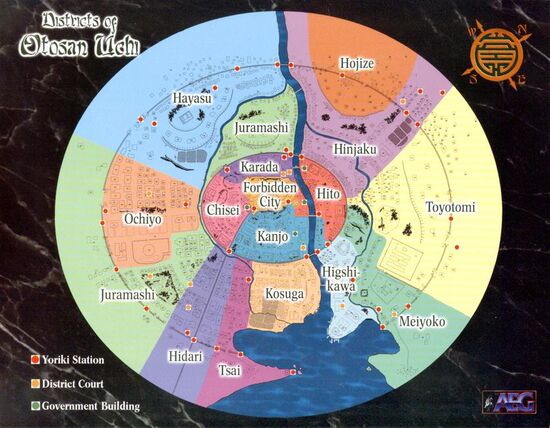
Map of Otosan Uchi circa 1123, showing the districts of the city
The Otosan Uchi Districts were the sixteen districts of the Imperial City Otosan Uchi, bordered by two gigantic walls.
Toshisoto: Outer disctricts
The areas outside the first and outermost wall were called Toshisoto and consisted of eleven districts (clockwise from Golden Sun Bay, direction as gauged from the Imperial Palace) [1] Usually named after their current governor, they also were given several nicknames by the city inhabitants adding major confusion. [2]
The Brutal Fame (Tsai) district
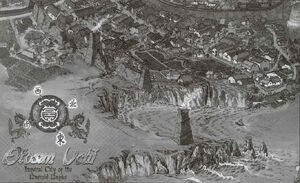
Tsai district
The Tsai district was located in the southeastern part of Otosan Uchi. [3] It was merged with the Kosuga district after the Scorpion Coup. [4] The district was merged with the Kosuga district in the newly named Yatoshin district. [5] It was nicknamed the Brutal Flame district. [6]
Notable Buildings
- Zankoku Hon'o, the Brutal Flame Tower.
Notable Governors
- Bayushi Tsai until the Scorpion Coup. [4]
- Mirumoto Kenro
The Emperor's Road (Hidari) district
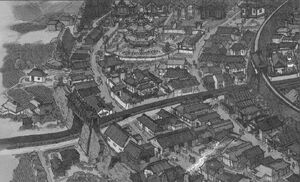
Hidari district
A jewel of the outer districts, there was nothing in the Hidari district that would offend the Emperor. This area was truly a construct of the Crane Clan, containing sword polishers, an origami shop, high-end restaurants and geisha houses. This area was normally heavily patrolled by Crane bushi when there were no Imperial Magistrates to do so. There was always an air of resentment to non-Crane clans here. [7] It was nicknamed the Emperor's Road district. [8]
Notable Buildings
- Soul's Light - Lantern shop.
Notable Governors
- Asahina Hidari around the time of the Scorpion Coup, always accompanied by his yojimbo Kakita Arisigato. [9]
The Juramashi district
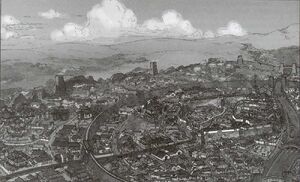
Juramashi district
The Juramashi district was a conglomerate of architecture and ideas. Upper Juramashi was largly residential and considered the more wealthy of the two. Lower Juramashi contained the lower caste housing, geisha and tea houses. Governors rarely lasted longer than one year in this area. [10]
Notable Buildings
Notable Governors
- Shiba Juramashi, for over a decade.
- Seppun Meyori, deposed shortly after the Scorpion Coup. [11]
- Doji Kurotama was a notable governor's advisor around the time of the Scorpion Coup.
The Spiritual (Ochiyo district / Mojiki) district
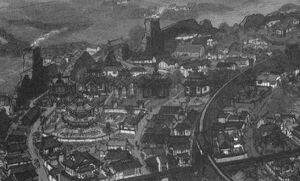
Ochiyo district
The Ochiyo district was the holy ground of the city. Seven temples dominated the district, with peaceful streets,lacking shops and its shouting heimins. A large population of Lion samurai choosen this district, patrolled it, and who practiced kenjutsu in the open field. [12] After the Coup it was renamed Mejiki district. [13] It was nicknamed the Spiritual district. [14]
Notable Buildings
Notable Governors
- Asako Ochiyo was a notable governor's advisor until the Scorpion Coup. [15]
- Seppun Mojiki [13]
The Gilded Hill (Hayasu) district
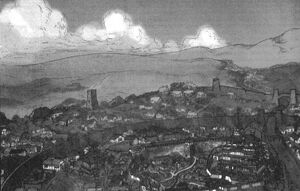
Hayasu district
The Hayasu district was one of the most affluent residential sections, and the home of the elite, wealthy merchants and artisans. The most elabrate homes were situated on the steep hill in the center. The streets were safe due to the high number of patrols, many of which were privately hired. The farmland in this district produced a high yield. [16] It was nicknamed the Gilded Hill district. [17]
Notable Buildings
- Sheltered Swords Neighborhood - Residential zone.
Notable Governors
- Shinjo Hayasu around the time of the Scorpion Coup. [16]
The Eta's Island (Hinjaku) district
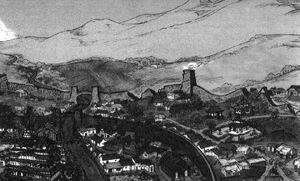
Hinjaku district
The Hinjaku district was a rich and vibrant area which was maintained to give visitors a beautiful impression of the Forbidden City. This area was a mix of private homes, temples, and merchant shops. [18] After the Scorpion Coup the district absorbed the Hojize district, but the new district was known as "Hojize". [19] It was nicknamed the Eta's Island district. [20]
Notable Buildings
- Ancestral Mausoleum - graves of notable heroes.
- Imperial Mausoleum - graves of the imperial families.
Notable Governors
- Mirumoto Hinjaku, also governor of the Hojize district at the same time at the time of the Scorpion Coup. [18]
The Rich Crescent (Hojize) district
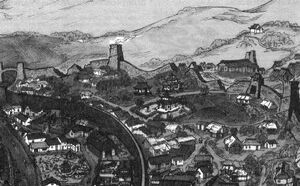
Hojize district
The Hojize district was possibly the least respected district, containing ruins, eta homes, questionable temples, and a crematorium. [21] After the Coup it was merged with the Hinjaku district, but the new district retained the "Hojize" name. [19] It was nicknamed the Rich Crescent district. [22]
Notable Buildings
Notable Governors
- Mirumoto Hojize, who died shortly before the end of the Scorpion Coup. [23]
The Prison/Moon (Toyotomi district / Teketshin) district
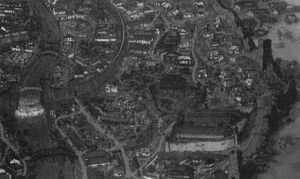
Toyotomi district
The Toyotomi district was always seen to be bustling. Once considered a filthy area, it was cleaned up by it's governor at the time Shiba Toyotomi. After the Scorpion Coup it reverted slightly to it's former degradation, but it still contained many artisan shops as well as high quality restaurants. [24] It was named Teketshin district after the Coup. [5] It was nicknamed the Prison/Moon district. [25]
Notable Buildings
- Kyuden Kokai - Prison
- Life's Love - Shintao Rock Garden
Notable Governors
- Shiba Toyotomi who died during the Scorpion Coup. [4]
- Isawa Teketshin after the Coup [5]
The Temari's Ruin (Meiyoko district / Mamoru) district
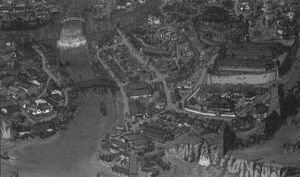
Meiyoko district
The Meiyoko district was largly run by the Shosuro family prior to the Scorpion Coup. After the coup the Yakuza obtained a firm grip. This area was once respected for its theatres, geisha, tea, and sake houses, and library. Much had been destroyed. [26] After the Coup the district was renamed Mamoru district, as usual after Yogo Mamoru was appointed as its governor. [11] It was nicknamed the Tenari's Ruin district. [27]
Notable Buildings
Notable Governors
The North Dock (Higshikawa) district
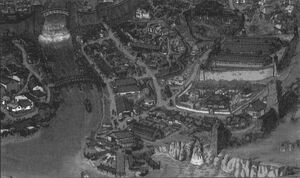
Higshikawa district
The Higshikawa district was governed named for Bayushi Higshikawa, and was governed by Shosuro Mukai until the Scorpion Coup, at which point Emperor's wife Bayushi Kachiko assumed management of the district. The area was also unoffically run by the Yakuza, and contained many warehouses and pleasure houses for the merchant class. The River of the Sun would often flood this district once or twice a year. [28] It was nicknamed the North Dock district. [29]
Notable Buildings
- Endless Journey - Agasha garden.
Notable Governors
- Bayushi Higshikawa. [30]
- Shosuro Mukai in 1123, later known as Otomo Mukai after the Scorpion Coup. [31]
The South Dock (Kosuga district / Yatoshin) district
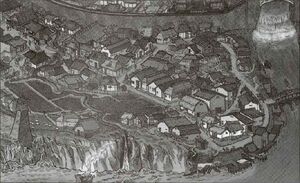
Kosuga district
Kosuga district was an amalgam of two sub-districts, Kosuga and Yatoshin district. [32] Most of Otosan Uchi's port trade occurred in the Kosuga district, and the area was well-maintained and highly populated. Even at night, heimin could be seen carrying torches leading workers to their jobs, and the area was considered to be middle-classed. There was also a small ronin population. [33] The Kosuga was merged with the Tsai district after the Coup, and it was called by the name of the former sub-district Yatoshin district. [5] It was nicknamed the South Dock district. [34]
Notable Buildings
- Yotsu Dojo - Ronin Dojo
Notable Governors
- Hida Kosuga around the time of the Scorpion Coup, although suffered interference by Yotsu Urieko. [33]
- Hida Urieko [5]
Ekohikei: Inner districts
Within the Enchanted Wall was the heart of Otosan Uchi, the Forbidden Palace district, and four other districts that surrounded the palace, called Ekohikei: [35]
Hito district
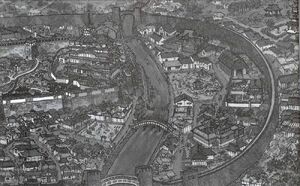
Hito district
Most notably located here was the Temple to the Kami, a shugenja site. Oddly enough, this area did not house the Phoenix embassy but instead, the Unicorn, western Lion, and Fox embassies. [36]
Notable Buildings
Notable Governors
- Ide Ukuri prior to the Scorpion Coup. [37]
Kanjo district
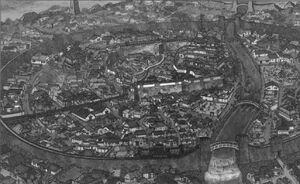
Kanjo district
The Kanjo district contained the southern gate and was the most traveled. Controlled primarily by the Lion Clan, it held the Lion, Phoenix, and Scorpion embassies. [38]
The Kanjo district became the home of Hantei XVI after his return to the mortal world through Oblivion's Gate in 1133. [39]
Notable Buildings
Notable Governors
- Shiba Kagi prior to the Scorpion Coup. [40]
Chisei district
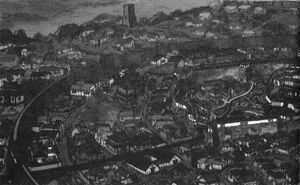
Chisei district
The Chisei district was considered the most beautiful area inside the inner walls. The "Emperor's Walk" cut straight between the Chisei and Kanjo districts and was the main road for both leading to the Forbidden City. The Crane and Minor Clan Embassies were located here, as well as the Temple to the Seven Fortunes. [41]
Notable Buildings
Notable Governors
- Kakita Foruku prior to the the Scorpion Coup. [42]
Karada district
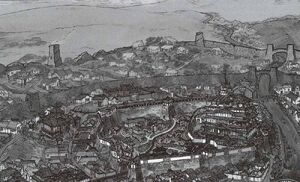
Karada district
The Karada district contained the Trading Grounds, largely Yasuki run although Tortoise were often seen here too. Also located in this area was the Crab embassy, the Imperial Museum of Antiquities, and the Forbidden City's sewer system. The wall in this area was managed by the Kuni family. [43]
Notable Buildings
- The Trading Grounds - Yasuki market
Notable Governors
- Hida Ryokai [44]
- Hida Reitaan prior to the Scorpion Coup, who had a history of rude outbursts. [44]
Forbidden City
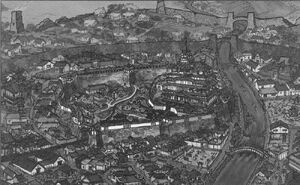
Forbidden City
Finally, at the center of the city on top of Seppun Hill was the Imperial Palace in the Forbidden City district. It was the heart of the Empire, surrounded by a 70 ft high wall. Sites here included, the Imperial Palace, Otomo and Seppun guest homes, the Imperial Water Gardens, the Temple to Hantei, and the Miya Palace. The Emperor and many of his personal attendants resided there, and the Imperial Court frequently gathered in the palace to hold court. [45]
Walls and Defensive Structures
- Miwaku Kabe, the Enchanted Wall
- Sunset Tower [46]
Beneath Otosan Uchi
Otosan Uchi was built in a location frequently plagued by earthquakes and typhoons. This had created a dynamic and shifting network of natural tunnels and cave systems beneath the entirety of the Imperial City. These natural formations were supplemented by manmade structures. Some of the major holdings and barracks in the city maintained siege supplies in the tunnels below their locations. [47]
Otosan Uchi districts after the Coup
After several modifications in the governors and shape of the districts this was the map of the Otosan Uchi districts around 1125.
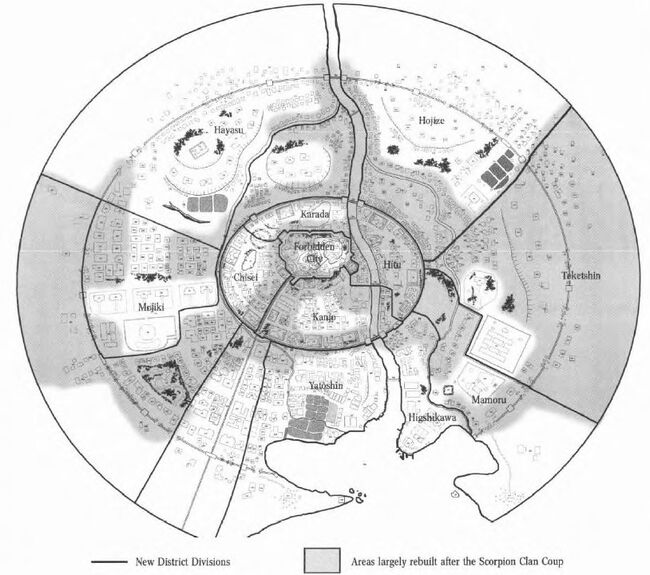
Otosan Uchi Districts in 1125
References
- ↑ Otosan Uchi:Book 1, p. 6 and Boxed Map
- ↑ The Atlas of Rokugan, p. 249-258
- ↑ Otosan Uchi:Book 1, p. 72
- ↑ 4.0 4.1 4.2 Otosan Uchi: The Scorpion's Sting, p. 80
- ↑ 5.0 5.1 5.2 5.3 5.4 Winter Court: Kyuden Kakita, p. 121
- ↑ The Atlas of Rokugan, p. 249
- ↑ Otosan Uchi:Book 1, p. 24
- ↑ The Atlas of Rokugan, p. 250
- ↑ Otosan Uchi:Book 1, p. 23
- ↑ Otosan Uchi:Book 1, p. 42
- ↑ 11.0 11.1 Winter Court: Kyuden Kakita, p. 119
- ↑ Otosan Uchi, p. 62
- ↑ 13.0 13.1 Winter Court: Kyuden Kakita, p. 120
- ↑ The Atlas of Rokugan, p. 252
- ↑ Otosan Uchi, p. 61
- ↑ 16.0 16.1 Otosan Uchi:Book 1, p. 17
- ↑ The Atlas of Rokugan, p. 253
- ↑ 18.0 18.1 Otosan Uchi:Book 1, p. 31
- ↑ 19.0 19.1 Winter Court: Kyuden Kakita, pp. 118-119
- ↑ The Atlas of Rokugan, p. 255
- ↑ Otosan Uchi:Book 1, p. 36
- ↑ The Atlas of Rokugan, p. 254
- ↑ Otosan Uchi: The Scorpion's Sting, p. 78
- ↑ Otosan Uchi:Book 1, p. 68
- ↑ The Atlas of Rokugan, p. 255
- ↑ Otosan Uchi:Book 1, p. 56
- ↑ The Atlas of Rokugan, p. 256
- ↑ Otosan Uchi:Book 1, pp. 27-28
- ↑ The Atlas of Rokugan, p. 257
- ↑ Otosan Uchi:Book 1, p. 27
- ↑ Winter Court: Kyuden Kakita, p. 118
- ↑ Otosan Uchi, p. 50
- ↑ 33.0 33.1 Otosan Uchi:Book 1, p. 49
- ↑ The Atlas of Rokugan, p. 258
- ↑ Otosan Uchi:Book 1, p. 79
- ↑ Otosan Uchi:Book 2, pp. 49-64
- ↑ Otosan Uchi:Book 2, p. 61
- ↑ Otosan Uchi:Book 2, pp. 24-27
- ↑ The Will of Heaven, by Rob Heinsoo
- ↑ Otosan Uchi:Book 2, p. 29
- ↑ Otosan Uchi:Book 2, pp. 33-44
- ↑ Otosan Uchi:Book 2, p. 36
- ↑ Otosan Uchi:Book 2, pp. 67-76
- ↑ 44.0 44.1 Otosan Uchi:Book 2, p. 67
- ↑ Otosan Uchi:Book 2, pp. 78-85
- ↑ Battle for Otosan Uchi, Part 1, by Rich Wulf and Shawn Carman
- ↑ The Atlas of Rokugan, p. 263
 |
This Imperial Families related article is a stub. That means that it has been started, but is incomplete. You can help by adding to the information here. |